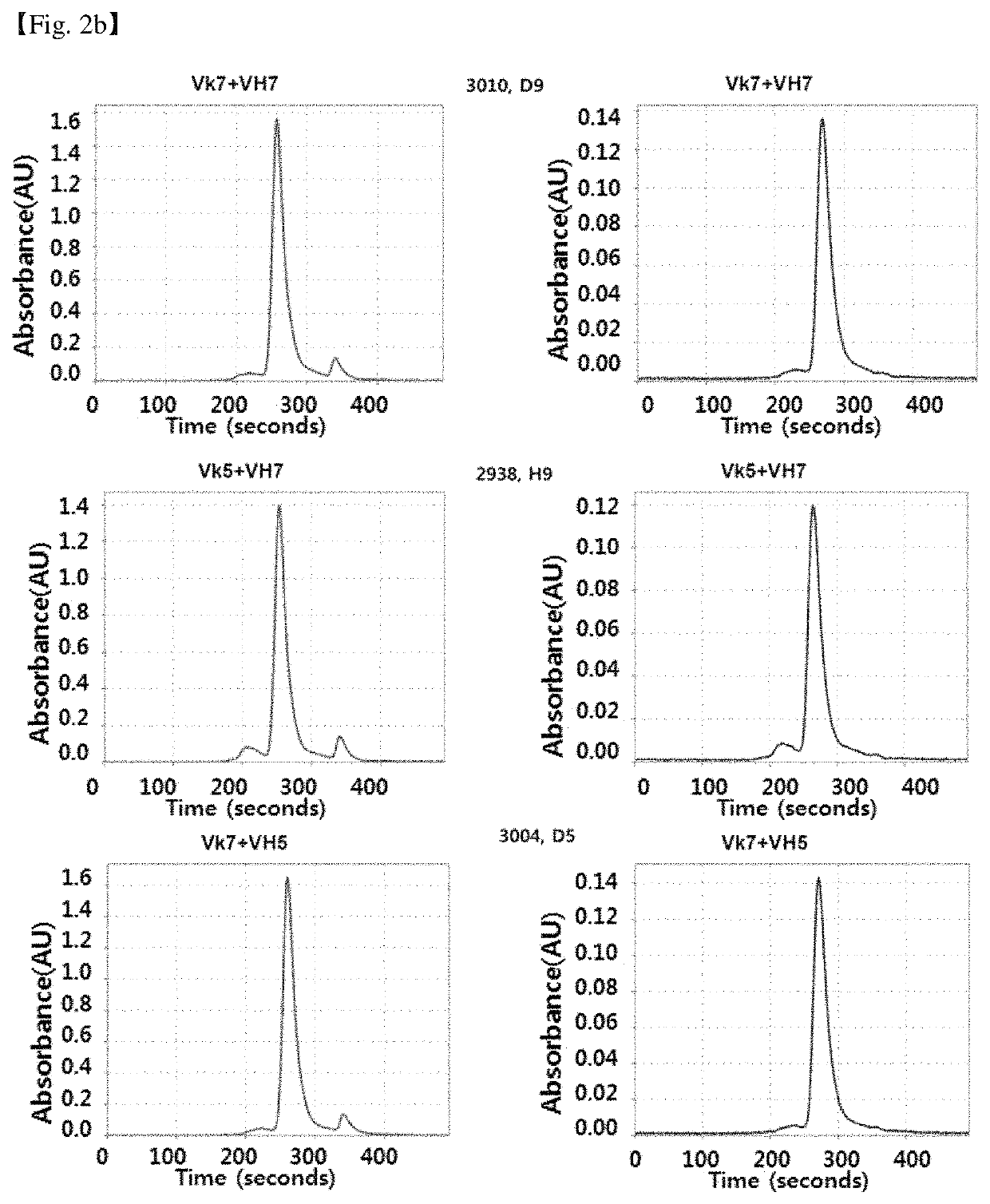Antibody binding specifically to CD66c and use thereof
an anti-cd66c and antibody technology, applied in the field of anti-cd66c antibodies, can solve the problems of normal cells destroying themselves
- Summary
- Abstract
- Description
- Claims
- Application Information
AI Technical Summary
Benefits of technology
Problems solved by technology
Method used
Image
Examples
example 1
on of Anti-CD66c Chimeric Antibody
[0101]1.1. Gene Sequence Cloning of Anti-CD66c Antibody
[0102]The 8F5 antibody gene was cloned using Mouse Ig-Primer Set (Millipore, Cat. #: 69831). The RNA isolated from the 8F5 hybridoma was PCR using the mouse Ig-primer set, inserted into a pGem-T vector (Promega, Cat. #: A3600), sequenced to confirm the DNA sequence, and the mouse antibody gene was identified through the IMGT site (www.imgt.org). The heavy chain variable region sequences and light chain variable region sequences of the analyzed 8F5 antibody are as follows.
[0103]
TABLE 4NamesequenceSEQ ID NO8F5-chimeric VH-CDR1ASGYSFTDYTMN 18F5-chimeric VH-CDR2LINPFHGGTVSNQRFKV 28F5-chimeric VH-CDR3VRGDPVRHYYALAY 38F5-chimeric VL-CDR1GASENVYGTLN 48F5-chimeric VL-CDR2GATNLAD 58F5-chimeric VL-CDR3VATYYCQNVLSAPYT 68F5-chimeric VHEVQLQQSGPELVKPGASMKISCKASGYSFTDYTMNWVKQS 7HGKNLEWIGLINPFHGGTVSNQRFKVKATLTVDVSSNTAYMELLSLTSDDSAVYYCVRGDPVRHYYALAYWGQGTSVTVSS8F5-chimeric VLDIQMTQSPASLSASVGETVTITCGASENVYGTLNWYQ...
example 2
on of Humanized Anti-CD66c Monoclonal Antibody
[0113]2.1 Selection of Recombinant Antibody Sequence by in Silico Humanization
[0114]CDRs (CDRH1: ASGYSFTDYTMN) SEQ ID NO: 1, CDRH2: SEQ ID NO: 2 (LINPFHGGTVSNQRFKV); CDRH3: SEQ ID NO: 3 (VRGDPVRHYYALAY); CDRL1: SEQ ID NO: 4 (GASENVYGTL); CDRL2: SEQ ID NO: 5 (GATNLAD); If CDR3: SEQ ID NO: 6 (VATYYCQNVLSAPYT) of the heavy chain of the mouse anti-CD66c antibody, 8F5 (heavy chain amino acid sequence: SEQ ID NO: 7, heavy chain encoding DNA: SEQ ID NO: 62; light chain amino acid sequence: SEQ ID NO: 8; light chain encoding DNA: SEQ ID NO: 63) were maintained as close to the antigen binding affinity as possible, or if the antigen binding affinity is equal or superior, the recombinant humanized antibody sequences based on the sequence of the framework region based on the germline sequence encoding the human antibody gene in silico method. The germline gene of human antibody used as a backbone of the recombinant humanized antibody sequence is mos...
example 3
tivity and Cancer Cell Death by Chimeric 8F5 Antibody
[0151]3.1. T Cell Active Cytokine Analysis and Cancer Cell Viability Analysis Following Co-Culture of CD8+ T Cells and Cancer Cells LS174T
[0152]CD8+ T cells were isolated from human blood cells using a MagniSort (registered trademark) Human CD8+ T cell Enrichment Kit (Ebioscience, cat. #: 8804-6812-74). 1×106 cells of CD8+ T cells and 2×105 cells of LS174T colorectal cancer cell were put into each well of a 6-well plate and a 10% FBS / RPMI medium were added to each well to be final volume of to 2 ml in each well and cultured. At this time, chimeric 8F5 antibody was treated to be 20 ug / ml. At 3rd and 5th days after the culture, 100 μl of each culture supernatant was taken and the amount of IFN-gamma and perform secretion of the culture supernatant were measured using a Human CD8 T+−Cell Magnetic Bead Panel (Millipore, Cat. #: HCD8MAG-15K) kit. After 7 days of incubation, the colorectal cancer cells LS174T were isolated and stained w...
PUM
 Login to View More
Login to View More Abstract
Description
Claims
Application Information
 Login to View More
Login to View More - R&D
- Intellectual Property
- Life Sciences
- Materials
- Tech Scout
- Unparalleled Data Quality
- Higher Quality Content
- 60% Fewer Hallucinations
Browse by: Latest US Patents, China's latest patents, Technical Efficacy Thesaurus, Application Domain, Technology Topic, Popular Technical Reports.
© 2025 PatSnap. All rights reserved.Legal|Privacy policy|Modern Slavery Act Transparency Statement|Sitemap|About US| Contact US: help@patsnap.com



